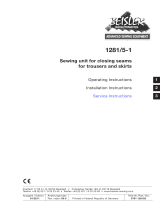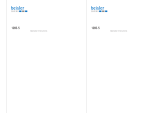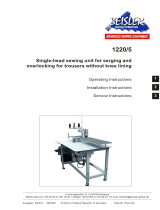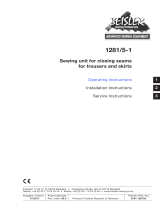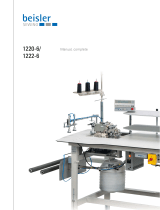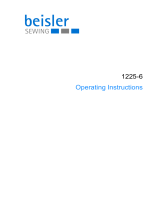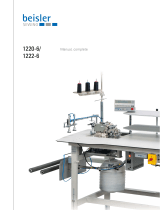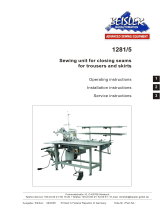Page is loading ...

1225/5
Single-head se wing unit for serging and
overlocking for trou sers with knee li ning
Operating Instructions
Installation Instructions
Servic Instructions
Frohn rad stra ße 10, D-63768 Hös bach
Telefon Ser vice +49 (0) 60 21/ 50 19 40 Telefax +49 (0) 60 21/ 54 00 61 E-mail: V[email protected]
1
2
3
Aus ga be /Edi ti on:06/2005Prin ted inFe de ral Re pub lic ofGer ma nyTei le-Nr.:/Part-No.:DOC000052


Foreword
This instruction manual is intended to help the user to become familiar
with the machine and take advantage of its application possibilities in
accordance with the recommendations.
The instruction manual contains important information on how to
operate the machine securely, properly and economically. Observation
of the instructions eliminates danger, reduces costs for repair and
down-times, and increases the reliability and life of the machine.
The instruction manual is intended to complement existing national
accident prevention and environment protection regulations.
The instruction manual must always be available at the
machine/sewing unit.
The instruction manual must be read and applied by any person that is
authorized to work on the machine/sewing unit. This means:
– Operation, including equipping, troubleshooting during the work
cycle, removing of fabric waste,
– Service (maintenance, inspection, repair and/or
– Transport.
The user also has to assure that only authorized personnel work on
the machine.
The user is obliged to check the machine at least once per shift for
apparent damages and to immediatly report any changes (including
the performance in service), which impair the safety.
The user company must ensure that the machine is only operated in
perfect working order.
Never remove or disable any safety devices.
If safety devices need to be removed for equipping, repairing or
maintaining, the safety devices must be
remounted directly after completion of the maintenance and repair
work.
Unauthorized modification of the machine rules out liability of the
manufacturer for damage resulting from this.
Observe all safety and danger recommendations on the machine/unit!
The yellow-and-black striped surfaces designate permanend danger
areas, eg danger of squashing, cutting, shearing or collision.
Besides the recommendations in this instruction manual also observe
the general safety and accident prevention regulations!

General safety instructions
The non-observance of the following safety instructions can cause
bodily injuries or damages to the machine.
1. The machine must only be commissioned in full knowledge of the
instruction book and operated by persons with appropriate
training.
2. Before putting into service also read the safety rules and
instructions of the motor supplier.
3. The machine must be used only for the purpose intended. Use of
the machine without the safety devices is not permitted. Observe
all the relevant safety regulations.
4. When gauge parts are exchanged (e.g. needle, presser foot,
needle plate, feed dog and bobbin) when threading, when the
workplace is left, and during service work, the machine must be
disconnected from the mains by switching off the master switch or
disconnecting the mains plug.
5. Daily servicing work must be carried out only by appropriately
trained persons.
6. Repairs, conversion and special maintenance work must only be
carried out by technicians or persons with appropriate training.
7. For service or repair work on pneumatic systems, disconnect the
machine from the compressed air supply system (max. 7-10 bar).
Before disconnecting, reduce the pressure of the maintenance
unit.
Exceptions to this are only adjustments and functions checks
made by appropriately trained technicians.
8. Work on the electrical equipment must be carried out only by
electricians or appropriately trained persons.
9. Work on parts and systems under electric current is not permitted,
except as specified in regulations DIN VDE 0105.
10. Conversion or changes to the machine must be authorized by us
and made only in adherence to all safety regulations.
11. For repairs, only replacement parts approved by us must be used.
12. Commissioning of the sewing head is prohibited until such time
as the entire sewing unit is found to comply with EC directives.
It is absolutely necessary to respect
the safety instructions marked by these signs.
Danger of bodily injuries !
Please note also the general safety instructions.

Index Page:
Preface and general safety instructions
Teil 1: Operating instructions cl. 1225/5
1. Description of product
1.1 Description of proper use ......................................... 3
1.2 Brief description ............................................... 3
1.3 Technical data ................................................ 4
2. Optional equipment ............................................ 5
3. Switching on - Switching off - Program stop
3.1 Switching on ................................................. 5
3.2 Switching off ................................................. 5
3.3 Program stop ................................................ 6
3.4 Restart after program stop ........................................ 6
4. Operation of the sewing machine head
4.1 General notes ................................................ 7
4.2 Recommended threads .......................................... 8
4.3 Removing / Putting on the fabric sliding sheet............................. 9
4.4 Setting the differential feed ........................................ 10
5. Operation of the sewing unit
5.1 Fusing station ................................................ 11
5.1.1 Inserting adhesive tape .......................................... 11
5.1.2 Switching the fusing station on and off ................................. 11
5.1.3 Fusing of knee lining and front trousers................................. 12
5.1.4 Cleaning the stamp ............................................. 13
5.2 Foot switch machine sequence ...................................... 14
5.3 Feeding the trousers parts and starting the sewing process .................... 14
5.4 Adjusting the edge guide ......................................... 16
5.5 Adjusting the blowing air for the nozzles in the table top ...................... 17
5.6 Stacker .................................................... 18
6. Operation of the control
6.1 Operator terminal .............................................. 19
6.2 User interface ................................................ 20
6.2.1 Menu structure of the sewing and setting programs ......................... 20
6.3 Seam programs ............................................... 22
6.4 Adjusting the control ............................................ 24
6.4.1 Altering seam-specific parameters.................................... 24
6.4.2 Altering global parameters ........................................ 27
6.4.3 Input - Output test.............................................. 28
1

Index Page:
6.4.4 Creation of seam programs ........................................ 29
6.4.5 Altering seam programs ( Changing / Completing the sequence) ................. 30
6.4.6 Deleting a seam program ......................................... 30
7. Error messages .............................................. 31
8. USB stick
8.1 General notes ................................................ 32
8.2 Formatting the USB stick ......................................... 32
8.3 Plugging the USB stick in the control .................................. 32
8.4 USB functions ................................................ 33
8.4.1 Storing data on the USB stick....................................... 35
8.4.2 Loading data from the USB stick ..................................... 35
8.4.3 Data comparison .............................................. 36
8.4.4 Deleting data from the USB stick..................................... 36
8.4.5 Loading software version from the USB stick ............................. 37
8.5 Removing the USB stick .......................................... 38
9. Maintenance
9.1 Cleaning and checking ........................................... 39
9.2 Oil lubrication ................................................ 41

1
1. Description of product
1.1 Description of proper use
The 1225/5 is a sewing unit which can properly be used for sewing
light to medium-weight material. Such material is, as a rule, made of
textile fibres. These materials are used in the garment industry.
In general only dry material should be sewn on this machine. The
material must not contain any hard objects.
The seam is generally made with core thread, polyester fibre
or cotton threads.
The dimensions for needle and hook threads can be taken from the
table in chapter 4.2.
Before using any other threads it is necessary to estimate the
consequential dangers and to take the respective safety measures, if
required.
This sewing unit must only be installed and operated in dry and
well-kept rooms. If the sewing unit is used in other rooms, which are
not dry and well-kept, further measures to be agreed upon may
become necessary (see EN 60204-31 : 1999).
We, as a manufacturer of industrial sewing machines, assume that at
least semi-skilled operating personnel will be working on our products
so that all usual operations and, where applicable, their risks are
presumed to be known.
1.2 Brief description
The Beisler 1225/5 is a single-head sewing unit for serging of trousers
parts with and without knee lining. The overlocking of the seat and fly
bow as well as of the trousers hem can be integrated.
For a displacement-free processing the lining is fused with the upper
fabric at a hot fusing station.
All sewing unit components are mounted on a stand welded of square
steel tubes and controlled by a microprocessor system.
The sewing unit is operated via a control panel. Here it is possible to
call up various control programs, to define new programs and to check
all inlets and outlets for maintenance and repair purposes.
Machine head
–
Pegasus two- or three-thread overlock machine
S52-134B
–
Direct drive Efka Type DC 1500 /AB 221
–
Microprocessor control, freely programmable
–
Light barrier for recognizing the seam beginning and seam end for
the automatic sewing start and stop
–
Height-adjustable edge guide for different material thicknesses
–
External control panel Efka V850 with:
- Menu navigation
- Freely programmable parameters for “machine
parameters”, “Global parameters”, “Program sequences”
- Input and output tests
- 20 program storage locations
- up to 7 seam programs per program storage location
3

–
Vertical cutter with suction for overlocking and serging in one
operation
–
Chain separator with suction, programmable
–
Adjustable blowing nozzles in the table top for supporting the
material feed
–
Height-adjustable stand, infinitely variable from 850 mm to
1200 mm
–
Integrated stacking device
1.3 Technical data:
Machine head: Pegasus S52-134B
Stitch type: 504/ 505
Number of needles: 1
Needle system: B27
Needle size: Nm 80 to Nm110
Threads: see table chapter 4.2
Speed: 8500 r/ min
Speed upon
delivery: 7500 r/ min
Stitch length: min. 1.0 mm
max. 5.0 mm
Seam width
Standard S52 head: 6 mm
Optional S52 head: 4 mm/ 5 mm
Material: Light to medium-weight material
Operating pressure: 6 bar
Air consumption: 20 NL per working cycle
Rated voltage: 1 x 230 V 50/60 Hz
Rated load: 0.9 kVA
Dimensions: 1500 x 900 x 1400 mm (L x W x H)
Working height: 850...1200 mm
(upper table top edge)
Weight: 120 kg
Noise level: LC = 81dB (A)
Workstation-specific emission value according to DIN 45635-48-B-1
Stitch length: 3 mm
Seam length: 1160 mm
Speed: 7000 r/min
Material: G1 DIN 23328 1 layer
Measuring point according to
DIN 4895 Part 1 X = 600 mm Y = 350 mm Z = 600 mm
x - axis = at right angles to the feeding direction
y - axis = main feeding direction
z - axis = height
4

1
5
2. Optional equipment
See annex
3. Switching on - Switching off - Program stop
3.1 Switching on
–
Switch on main switch 1 (turn in clockwise direction).
The control loads the machine program.
The basic display appears in the display of the control panel.
3.2 Switching off
–
Switch off main switch 1 (turn counter-clockwise).
1

3.3 Program stop
For an immediate stop in case of operating errors, needle breakage
etc. the safety system of the 1225/5 provides the following measures:
–
Press program stop switch 2 at the control panel.
The running operations are stopped immediately.
–
Turn main switch 1 counter-clockwise.
The sewing unit drops out immediately;
all movements of the sewing unit stop immediately.
3.4 Restart after program stop
Caution: Risk of injury!
Switch the main switch off.
Clear the fault only with the sewing unit switched off.
Only restart the sewing unit after the fault has been cleared.
–
Switch on main switch 1 (turn in clockwise direction).
–
Unlock the program stop switch.
The control loads the machine program.
The basic display appears in the display of the control panel.
The sewing unit is ready for operation again.
6
2 1
2

4. Operation of the sewing machine head
4.1 General notes
The operation of the sewing machine head (needle insertion, threading
of needle thread and hook thread etc.) is described in the attached
separate Pegasus operating instructions.
The instruction manual is included in the accessories of the sewing
unit.
Attention: Risk of injury!
Please read the operating instructions of the sewing machine head
carefully and observe all notes on safety.
7
1

4.2 Recommended threads
Needle system: B27
Recommended
needle size: Nm 80 for very thin material
Nm 90 for thin material
Nm 100 for medium-weight material
High sewing security and good sewability are achieved with the
following core threads:
–
Two-ply polyester endless polyester core-spun
(e.g. Epic Poly-Poly, Rasant x, Saba C, ...)
–
Two-ply polyester endless cotton core-spun
(e.g. Frikka, Koban, Rasant, ...)
If these threads are not available, the polyester fibre or cotton threads
listed in the table can also be sewn.
Often two-ply core threads are offered by the thread manufacturers
with the same designation as three-ply polyester fibre threads
(3cyl.-spun).This causes uncertainty with regard to twisting and thread
thickness.
When in doubt, unravel the thread and check whether it is twisted 2- or
3-ply.
The label no. 120 on the thread reel of a core thread corresponds e.g.
to the thread size Nm 80/2 (see table values in brackets).
In case of monofilament threads you can use needle threads and hook
threads of the same thickness. The best results are achieved with soft
and elastic threads (software) of the thread thickness 130 Denier.
Recommended thread thicknesses:
Needle size Core thread Core thread
Nm
Needle thread Hook thread Needle thread Hook thread
Polyester Polyester Polyester Cotton
endless core-spun endless core-spun
Label No. Label No. Label No. Label No.
80
90 120 (Nm 80/2) 120 (Nm 80/2) 120 (Nm 80/2) 120 (Nm 80/2)
100 100 (Nm 65/2) 100 (Nm 65/2) 100 (Nm 65/2) 100 (Nm 65/2)
Needle size Polyester fibre thread Cotton thread
Nm (3cyl.-spun)
Needle thread Hook thread Needle thread Hook thread
80 Nm 120/3 Nm 120/3 Ne
B
60/3-80/3 Ne
B
60/3-80/3
90 Nm 80/3-120/3 Nm 80/3-120/3 Ne
B
50/3-70/3 Ne
B
50/3-70/3
100 Nm 70/3-100/3 Nm 70/3-100/3 Ne
B
40/3-60/3 Ne
B
40/3-60/3
8

4.3 Removing / Putting on the fabric sliding sheet
The fabric sliding sheet 2 is held in the gap of the table top by the
magnets 1.
The edge guide 3 is fastened on the fabric sliding sheet.
Removing the fabric sliding sheet
–
Carefully remove the edge guide 3 from the magnets in upward
direction.
–
Swivel the fabric sliding sheet aside.
The lower section of the sewing machine head is accessible now.
Putting on the fabric sliding sheet
–
Push the fabric sliding sheet into the gap of the table top and insert
in downward direction.
1
9
2 1
2 3

4.4 Setting the differential feed
By the differentials the behaviour of the feed-dogs can be altered.
Permanent differential
The left lever 2 (seen from behind) influences the permanent
differential, which is active during the whole sewing process.
The setting range is between -10 and + 6.
The higher the setting (positive numbers),the more the material is
gathered. The lower the setting (negative numbers), the more the
material is stretched.
Additional differential
The right lever 1 influences the additional differential, which is
programmable in the control and provides additional width in certain
seam sections only.
The setting range is between 0 and + 16.
The higher the positive number, the more additional lining is gathered
at the programmed positions.
10
2 1

5. Operation of the sewing unit
5.1 Fusing station
5.1.1 Inserting adhesive tape
–
Remove the right supporting disk by pulling the handle 1 strongly.
–
Insert a new roll of adhesive tape 2.
The full roll must rotate counter-clockwise when unwinding.
–
Push the right supporting disk with handle 1 on the shaft again until
it catches.
–
Guide adhesive tape through guide 3.
–
Open flap 4 upwards.
–
Separate adhesive tape 2 from the carrier material 5.
–
Guide adhesive tape 2 under the flap 4 and draw it under the
clamp 7.
–
Guide the carrier material 5 downwards behind the transport
roller 6.
–
Close flap 4.
5.1.2 Switching the fusing station on and off
–
The yellow signal lamp 1 “Power” lights up after the main switch
has been switched on.
–
Press toggle switch 2 in position “ON”.
Note
As long as the signal lamp 3 “Heat” flashes, the lower stamp is being
heated up and has not yet reached the necessary temperature.
11
1
7 6 5 4 2
4 3 2 1
3 2 1

5.1.3 Fusing of knee lining and front trousers
Caution: Risk of burn!
Do not touch the area around the fusing station.
The lower stamp is very hot.
To avoid a displacement of the knee lining during the sewing process a
bonding point has to be set with the fusing station fusing the lining at
the correct position.
–
Position knee lining 3 under clamp 2.
–
Press clamp key 1.
The clamp 2 lowers and clamps the knee lining.
The fusing tape 5 is pushed forward simultaneously and the
net-like fusing tape 8 is separated from the release paper.
–
Position trousers part 7 and align as per the lining.
–
Press fusing key 4.
The upper stamp 6 moves downwards, the lower heated stamp
moves upwards so that trousers part and lining are pressed with
the fusing tape lying in between.
After the preset fusing time the upper stamp 6 and clamp 2 are
lifted automatically and the lower stamp is lowered.
Lining and trousers part are fused now and can be fed for
overlocking.
12
7 6 5 4
3 2 1
8 5

5.1.4 Cleaning the stamp
Caution: Risk of burn!
Clean the stamp only when it is cold.
–
Throw toggle switch 1.
The lower stamp 2 moves upwards.
–
Clean the stamp.
–
Actuate toggle switch 1 again.
The lower stamp 2 moves downwards.
13
1
1
2

5.2 Foot switch machine sequence
In some of the seam programs the foot switch serves for releasing
various functions.
The foot switch is equipped with two contacts.
One of them is located at the rear and is released by stepping back.
The other one is located at the front and is released by pressure of the
heel.
5.3 Feeding the trousers parts and starting the sewing process
The overlock unit 1225/5 works semi-automatically.
The operator of the sewing unit has to do the following:
® call up the desired seam program;
® fuse upper fabric and knee lining at the fusing station;
® feed the workpiece precisely;
® supervise the sewing process of the sewing unit;
® take the finished parts out of the stacker.
Feeding the trousers part and starting the sewing process
1) Select the seam program at the control panel (see chapter 6.3).
2) Place the trousers part 1 from the right on the table top 2 and
straight underneath the contour guide 3.
ATTENTION!
As soon as the trousers part has been pushed under the light barrier 4,
the sewing process starts automatically and the contour guide 3
lowers.
14
2 1
4 3

3) The trousers part is sewn.
4) As soon as the workpiece has left the light barrier,the seam is
finished and both stamps 6 lower.
5) The contour guide moves upwards.
6) The swivelling device 5 transports the material out of the sewing
area.
7) The stacker clamp 8 moves to the front.
8) The stamps 6 move upwards again.
9) The trousers part is stacked.
10) Actuate foot switch 7 for removing the workpieces.
Note
In order to facilitate the material feed in the area of the sewing head
the table blowing can be engaged. (see chapter 5.5)
15
1
6 5
8 7

5.4 Adjusting the edge guide
The height-adjustable edge guide ensures a precise positioning of the
trousers part in front of the sewing head. The height of the edge guide
can be adjusted depending on the thickness of the material to be
processed.
The draw roll 3 guarantees a precise material feed under the sewing
foot.
Adjusting the height of the edge guide
–
Draw the dial 1 in the direction of arrow.
–
Set the dial 1 to one of the four lock-in positions.
Position 1 = minimum height
Position 4 = maximum height
Fine adjustment of the height of the edge guide
–
Turn the dial 2 correspondingly.
Setting the contact pressure of the roller 4
–
Turn the dial 3 in clockwise direction
the contact pressure of the roller is increased
–
Turn the dial 3 counter-clockwise
the contact pressure of the roller is reduced
16
4 3 2 1
/
